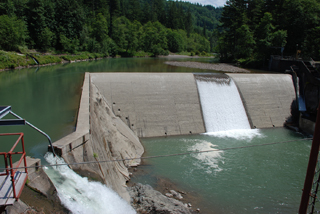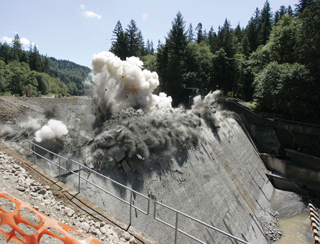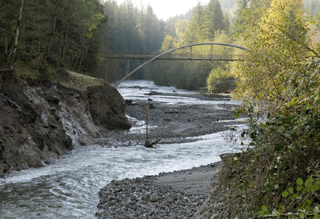|
Subscribe / Renew |
|
|
Contact Us |
|
| ► Subscribe to our Free Weekly Newsletter | |
| home | Welcome, sign in or click here to subscribe. | login |
Architecture & Engineering
| |
 |
October 28, 2010
What PGE learned while removing Marmot Dam
Portland General Electric

Keller
|
With the Elwha and Glines Canyon dams set for removal next year in Washington, attention is turning to how such massive structures are actually taken down. One of the most recent dams removed in the Northwest was Marmot Dam on Oregon’s Sandy River.
Portland General Electric in 2007 removed Marmot Dam, which was part of the Bull Run Hydroelectric Project.
In November of 1999, PGE filed a notice not to seek a new federal license for the Bull Run project near the city of Sandy. PGE decided that it would not make sense to upgrade the nearly century-old facility to meet current standards for protection, mitigation and enhancement of the natural resources affected by the project — especially salmon and steelhead runs on the Sandy River. The likely cost would outweigh the economic benefit to PGE customers from power generation at the project.
The Bull Run project was located about 30 miles east of Portland on the western slopes of Mount Hood, and consisted of:
• Marmot Dam, a 47-foot-high, 345-foot-long roller-compacted concrete dam that was built in 1989 to replace an earlier timber structure.
• Little Sandy Dam, a small concrete diversion dam on the Little Sandy River.
• A complex system of connecting canals and flumes.
• A 22-megawatt powerhouse.
• Roslyn Lake, a 160-acre forebay located 320 feet above the powerhouse.
Water was diverted from the Sandy and Little Sandy rivers to Roslyn Lake. From there, flow was delivered to the powerhouse and then discharged to the Bull Run River after passing through power-generating turbines.
Approximately 980,000 cubic yards of sediment — silt, gravel, cobbles and boulders — had accumulated behind Marmot Dam during its lifetime.
After convening a group to develop a decommissioning and removal plan — a process involving 23 governmental and nonprofit organizations and literally years of collaborative effort — PGE committed to removing the dam within one construction season in 2007, extracting only as much sediment as was required for the demolition. The remaining sediment would be allowed to disperse with natural stream flow.
PGE and stakeholders hoped that this approach would minimize the impact of excavation and truck traffic on the riverbed and surrounding landscape. It would also minimize transportation costs that would ultimately be borne by PGE customers.
PGE solicited bids for Marmot Dam removal in March of 2007, requiring bidders to follow a predetermined format with information on pricing, labor and equipment rates, a hazardous material plan, a demolition plan, project schedule, risk analysis and qualifications.
PGE then evaluated bids and awarded the contract to Natt McDougall Co. Work began almost immediately.
To allow demolition of the instream structures, workers placed a cofferdam upstream and another downstream of the dam. Project engineers designed the cofferdams to fail during normally high stream flows expected to occur in the fall after the dam was scheduled to be removed.
After work was completed on the cofferdams and the river water diverted around the work area, excavators removed the sediments behind the dam. Then, the dam was fractured by drilling and controlled blasting operations and removed by excavators as well.
When forecasts called for river flows above 1,500 cubic feet per second on Oct. 19, 2007, PGE and McDougall prepared to initiate the cofferdam breach. Using a forklift, McDougall workers removed dewatering pumps that had been installed to assure the integrity of the upstream cofferdam and started scraping a notch in the cofferdam down to water level with the machine. As flow through the notch increased it quickly cut away sediment, taking less than 30 minutes to reach full flow diversion.
This flow was also enough to breach the downstream cofferdam, allowing maximum sediment transport and timely creation of a passable channel though the sediment for salmon.
Since the breach, the movement of the sediments and fish migration has been monitored by PGE, research groups, federal and state agencies. The consensus is that the recuperative power of the Sandy River proved to be much greater than expected in such a short time.
Here are the lessons learned:
1. Form a strong project team. The project team managed by PGE consisted of engineering design and research firms, biologists, hydrologists and fisheries experts. Coordinated by PGE’s hydro licensing staff, there were several sessions during the design process to inform, gather consensus and work through the more difficult issues, which usually were fish passage details.
2. Get early feedback and involvement from all permitting agencies. Even with biological opinions in place from the state and federal fish management agencies, the joint permit application to the Oregon Department of State Lands and the Army Corps of Engineers required PGE to perform a more stringent sedimentation analysis and resulted in a one-year delay to the start of decommissioning. Getting early feedback and involvement is essential to ensure a timely and cost-effective result.
3. Contractor selection is critical. The selection of a trustworthy contractor who will work closely with the owner to develop efficient work strategies is a key element of any project’s success and was especially important for the Marmot Dam removal. McDougall provided valuable insight and worked with PGE to minimize the overall project cost and impacts while fulfilling decommissioning commitments.
4. Plan ahead. Planning for the Marmot Dam removal incorporated all concerns introduced by federal and state agencies as well as the project team. This included contingency planning in case events did not unfold as expected.
5. Demolition is not an exact science. Engineers design a structure like Marmot Dam conservatively; it takes knowledge, experience and good judgment to determine how best to apply enough but not too much force to demolish it.
6. Be ready to adapt quickly. The Sandy River has more than 90 years of historical river flow data and PGE had access to state-of-the-art flow predictions and forecasts. Even so, flows could not be accurately predicted more than 12 hours in advance. The contractor had to be able to respond with short notice to initiate the breach procedure.
7. Prepare for the impact of news media and researchers. There was a concern that the news media and researchers would slow the project. Careful planning and centralized communications with the media alleviated any problems. There was a small impact on productivity as PGE responded to news media and stakeholder interest in viewing the first blast event.
8. Work early and cooperatively with the ultimate land owner. In this case the land owner was the federal Bureau of Land Management. BLM explained its plans to PGE, helping to avoid unnecessary work through site visits and design coordination.
Another, more general lesson illustrated by the decommissioning process at the Bull Run Hydroelectric Project is that no two projects are alike.
Decommissioning and removal of Marmot Dam was a success for both PGE’s customers and the environment, and PGE worked closely with government agencies, advocacy groups and technical experts to assure that the plan was executed smoothly. The results exceeded expectations and provide a model for other dam removal projects.
PGE has faced relicensing at other hydroelectric projects in recent years, however, and found that the same kind of cost and benefit analysis can yield very different results at different facilities.
At PGE’s T.W. Sullivan Plant on the Willamette River, the company opted to make significant investments in upgraded fish passage facilities, because analysis showed that the improvements would benefit customers even though the hydroelectric plant was actually older than Bull Run’s.
And at the Pelton Round Butte Hydroelectric Project on the Deschutes River in Central Oregon, PGE completed a one-of-a-kind fish passage and water temperature management facility last year. PGE is also committed to a comprehensive strategy of helping to improve habitat and reintroduce fish runs that were blocked when the project was constructed in the 1960s.
Improvements at the Sullivan Plant and Pelton Round Butte have earned both projects Low Impact Hydro certification.
In each case, the goal has been to produce the same win-win result for PGE customers and the environment, but the strategy chosen to get there was developed to fit the specific circumstances. The common element is that PGE has conducted extensive outreach and engaged stakeholder groups and government agencies to assure that all perspectives are taken into account and every effort is made to address potential questions, concerns and problems as the process unfolds.
That’s true for the planning stages, and — as demonstrated by the Marmot Dam decommissioning — carries through to implementation of the resulting plan.
Tim Keller is a construction manager with Portland General Electric’s Power Supply Engineering Services group. He has 30 years of construction and project management experience at PGE.
Other Stories:
- Buck the recession with strategies for success
- Architectural viability can enhance mixed-use projects
- Creating successful projects in a difficult market
- Play ‘matchmaker’ with your staff to get work
- What your HVAC techs aren’t telling you
- What the U.S. and China can learn from one another
- Using technology as a springboard to new work
- Why A/E firms should care about social media
- Data center design focuses on five fundamentals
- Have you secured your firm's value?
- Swedish’s Issaquah project taps into energy rebates





